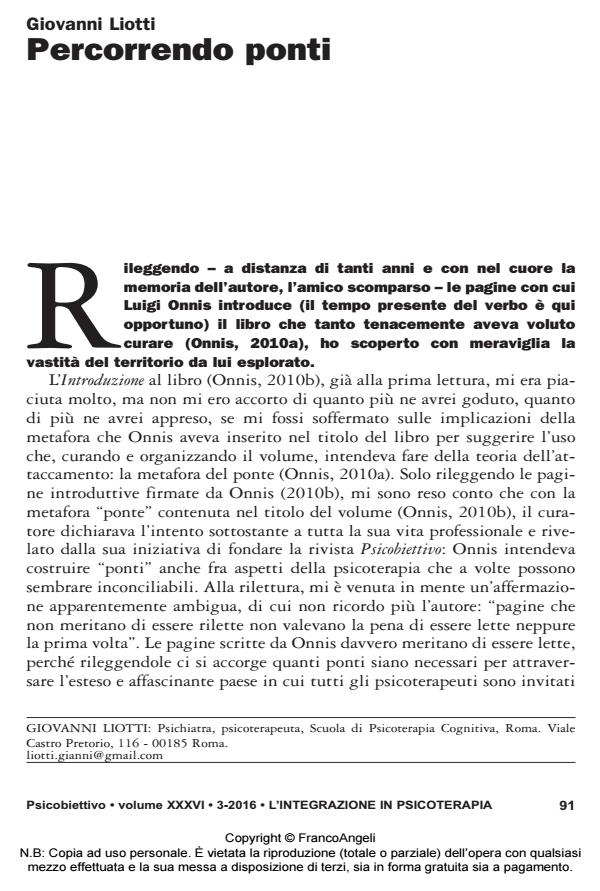Crossing bridges
Journal title PSICOBIETTIVO
Author/s Giovanni Liotti
Publishing Year 2016 Issue 2016/3 Language Italian
Pages 6 P. 91-96 File size 85 KB
DOI 10.3280/PSOB2016-003005
DOI is like a bar code for intellectual property: to have more infomation
click here
Below, you can see the article first page
If you want to buy this article in PDF format, you can do it, following the instructions to buy download credits

FrancoAngeli is member of Publishers International Linking Association, Inc (PILA), a not-for-profit association which run the CrossRef service enabling links to and from online scholarly content.
The introduction to the book on attachment edited by Luigi Onnis in 2010, which we are invited to comment in this issue of Psicobiettivo, emphasizes one of the most precious human and scientific qualities that have made treasured the curator: the ability to put in comparison among them, effectively and with equal respect for the different opinions, the theoretical and practical perspectives that make up the varied territory of psychotherapy. In this paper I have tried not only emphasize the breadth of themes, all correlated to the attachment theory, which are treated differently by the various schools of psychotherapy, which Luigi Onnis was able to master not only through "building" bridges among them, but also with his inimitable style when comparing different theoretical and clinical perspectives.
Keywords: Attachment; Motivations; Emotions; Psychoanalysis; Evolutionary Cognitive Psychology; Cognitive Constructivist
- Bowlby J. (1969) Attaccamento e Perdita, Volume 1, Bollati Boringhieri, Torino, 1972
- Liotti G. (2015) “Psicoterapia ispirata dalla teoria dell’attaccamento: Una prospettiva basata sulla teoria evoluzionista dei sistemi motivazionali”, Attaccamento e Sistemi Complessi, 2 (1): 11-26
- Liotti G. (2016) “Infant attachment and the origins of dissociative processes: An approach based on the evolutionary theory of multiple motivational systems”, Attachment: New Directions in Psychotherapy and Relational Psychoanalysis, 10: 20-36
- Onnis L. (a cura di) (2010a) Legami che creano, legami che curano. Attaccamento: Una teoria ponte per le psicoterapie, Bollati Boringhieri, Torino
- Onnis L. (2010b) “Introduzione”, in Legami che creano, legami che curano. Attaccamento: Una teoria ponte per le psicoterapie (a cura di L. Onnis), Bollati Boringhieri, Torino
- Sroufe L.A. (1996) Lo sviluppo delle emozioni: i primi anni di vita (trad. it.: Raffaello Cortina, Milano, 2000)
Giovanni Liotti, Percorrendo ponti in "PSICOBIETTIVO" 3/2016, pp 91-96, DOI: 10.3280/PSOB2016-003005